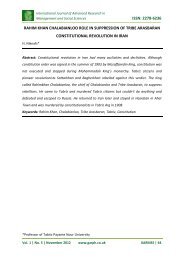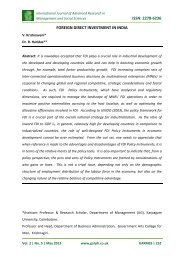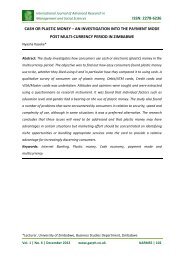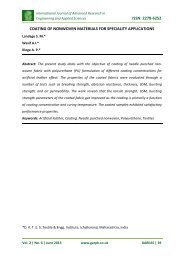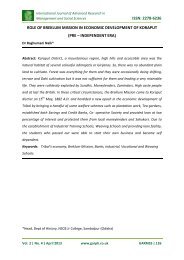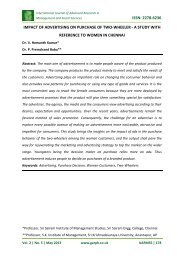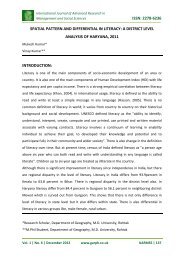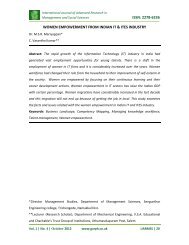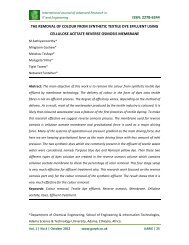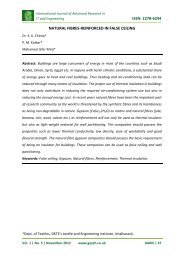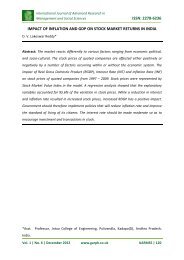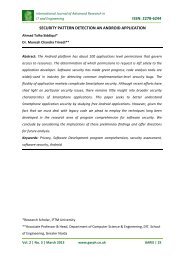CONSTRUCTION OF SINGLE SAMPLING PLAN ... - Garph.co.uk
CONSTRUCTION OF SINGLE SAMPLING PLAN ... - Garph.co.uk
CONSTRUCTION OF SINGLE SAMPLING PLAN ... - Garph.co.uk
You also want an ePaper? Increase the reach of your titles
YUMPU automatically turns print PDFs into web optimized ePapers that Google loves.
International Journal of Advanced Research in<br />
IT and Engineering ISSN: 2278-6244<br />
SELECTION <strong>OF</strong> MIXED <strong>SAMPLING</strong> <strong>PLAN</strong> WITH QSS-2(n;c N ,c T ) <strong>PLAN</strong> AS<br />
R. Sampath Kumar*<br />
M. Indra**<br />
R. Radhakrishnan***<br />
ATTRIBUTE <strong>PLAN</strong> INDEXED THROUGH MAPD AND LQL<br />
Abstract: This paper presents the procedure for the <strong>co</strong>nstruction and selection of the mixed<br />
sampling plan using MAPD as a quality standard with the QSS-2 (n;c N, c T ) plan as attribute<br />
plan. The plans indexed through MAPD and LQL are <strong>co</strong>nstructed and <strong>co</strong>mpared for their<br />
efficiency. Tables are <strong>co</strong>nstructed for easy selection of the plan.<br />
Keywords and Phrases: Limiting quality level, maximum allowable percent defective,<br />
operating characteristic, tangent intercept.<br />
AMS (2000) Subject Classification Number: Primary: 62P30 Se<strong>co</strong>ndary: 62D05<br />
*Assistant Professor, Department of Statistics, Government Arts College, Coimbatore, Tamil<br />
Nadu, India<br />
**Assistant Professor, Department of Statistics, Muthayammal <strong>co</strong>llege of Arts and Science,<br />
Rasipuram, Tamil Nadu, India<br />
***Associate Professor, Department of Statistics, PSG College of Arts and Science,<br />
Coimbatore, Tamil Nadu, India<br />
Vol. 1 | No. 2 | August 2012 www.garph.<strong>co</strong>.<strong>uk</strong> IJARIE | 19
International Journal of Advanced Research in<br />
IT and Engineering ISSN: 2278-6244<br />
1. INTRODUCTION<br />
Mixed sampling plans <strong>co</strong>nsist of two stages of rather different nature. During the first stage<br />
the given lot is <strong>co</strong>nsidered as a sample from the respective production process and a<br />
criterion by variables is used to check process quality. If process quality is judged to be<br />
sufficiently good, the lot is accepted. Otherwise the se<strong>co</strong>nd stage of the sampling plan is<br />
entered and lot quality is checked directly by means of an attribute sampling plan.<br />
There are two types of mixed sampling plans called independent and dependent plans. If<br />
the first stage sample results are not utilized in the se<strong>co</strong>nd stage, the plan is said to be<br />
independent otherwise dependent. The principal advantage of a mixed sampling plan over<br />
pure attribute sampling plans is a reduction in sample size for a similar amount of<br />
protection.<br />
The se<strong>co</strong>nd stage attribute inspection be<strong>co</strong>mes more important to discriminate the lot if the<br />
first stage variable inspection fails to accept the lot. If rejection occurs during the normal<br />
inspection, tightened inspection is re<strong>co</strong>mmended in the mixed system and vice versa in the<br />
se<strong>co</strong>nd stage. Hence Quick Switching System is imposed in the se<strong>co</strong>nd stage to sharpen the<br />
sampling situation and to insist the producer to manufacture goods within the Limiting<br />
Quality Level. Dodge (1967) proposed a sampling system called a ‘Quick Switching System’<br />
(QSS) <strong>co</strong>nsisting of pairs of normal and tightened plans.<br />
Schilling (1967) proposed a method for determining the operating characteristics of mixed<br />
variables –attributes sampling plans, single sided specification and standard deviation<br />
known using the normal approximation. Devaarul (2003), Sampath Kumar (2007), Sampath<br />
Kumar, Indra and Radhakrishnan (2012a, 2012b, 2012c, 2012d) have made <strong>co</strong>ntributions to<br />
mixed sampling plans for independent case. Sampath Kumar et.al (2012) studied mixed<br />
sampling plan for independent case. QSSs were originally proposed by Dodge (1967) and<br />
investigated by Romboski (1969) and Govindaraju (1991).Dodge (1967) proposed a new<br />
sampling system <strong>co</strong>nsisting of pairs of normal and tightened<br />
with attributes by Romboski (1969)<br />
plans. QSS developed<br />
is a reduction in the sample size required to<br />
achieve approximately the same operating characteristic curve.<br />
In this paper, using the operating procedure of mixed sampling plan with QSS-2(n;c N ,c T ) plan<br />
as attribute plan, tables are <strong>co</strong>nstructed for the mixed sampling plan indexed through (i)<br />
Vol. 1 | No. 2 | August 2012 www.garph.<strong>co</strong>.<strong>uk</strong> IJARIE | 20
International Journal of Advanced Research in<br />
IT and Engineering ISSN: 2278-6244<br />
MAPD (ii) LQL ( limiting quality level). This plan indexed through MAPD is <strong>co</strong>mpared with<br />
the plan indexed through LQL. Suitable suggestions are also provided for future research.<br />
2. GLOSSARY <strong>OF</strong> SYMBOLS<br />
The symbols used in this paper are as follows:<br />
p<br />
: submitted quality of lot or process<br />
P a (p) : probability of acceptance for given quality ‘p’<br />
p 2<br />
p *<br />
: the submitted quality such that P a (p 2 ) = 0.10 (also called LQL)<br />
: maximum allowable percent defective (MAPD)<br />
h * : relative slope at ‘p * ’<br />
n 1<br />
n 2<br />
c N<br />
c T<br />
: sample size of variable sampling plan<br />
: sample size of attribute sampling plan<br />
: acceptance number of normal inspection<br />
: acceptance number of tightened inspection<br />
β j : probability of acceptance for lot quality ‘p j ’<br />
β j ' : probability of acceptance assigned to first stage for percent defective ‘p j ’<br />
β j " : probability of acceptance assigned to se<strong>co</strong>nd stage for percent defective ‘p j ’<br />
d<br />
z(j)<br />
k<br />
: observed number of non<strong>co</strong>nforming units in a sample of n units<br />
: ‘z’ value for the j th ordered observation<br />
: variable factor such that a lot is accepted if X ≤ A = U - kσ<br />
3. OPERATING PROCEDURE <strong>OF</strong> MIXED <strong>SAMPLING</strong> <strong>PLAN</strong> QSS-2(N;C N ,C T ) AS<br />
ATTRIBUTE <strong>PLAN</strong><br />
Schilling (1967) has given the following procedure for the independent mixed sampling plan<br />
with Upper specification limit (U) and known standard deviation (σ).<br />
Determine the parameters of the mixed sampling plan n 1 , n 2 , k, c N and c T. .<br />
<br />
Take a random sample of size n 1 from the lot.<br />
If a sample average X ≤ A = U - kσ, accept the lot.<br />
If a sample average X > A = U - kσ, go to step 1.<br />
Step 1: From a lot, take a random sample of size n 2 at the normal level. Count the<br />
number of defectives ‘d’<br />
If d ≤ c N , accept the lot and repeat step 1.<br />
Vol. 1 | No. 2 | August 2012 www.garph.<strong>co</strong>.<strong>uk</strong> IJARIE | 21
International Journal of Advanced Research in<br />
IT and Engineering ISSN: 2278-6244<br />
If d > c N , reject the lot and go to step 2.<br />
Step 2: From the next lot, take a random sample of size n 2 at the tightened level. Count<br />
<br />
<br />
the number of defectives ‘d’<br />
If d ≤ c T , accept the lot and use step 1 for the next lot.<br />
If d > c T , reject the lot and repeat step 2 for the next lot.<br />
4. <strong>CONSTRUCTION</strong> <strong>OF</strong> MIXED <strong>SAMPLING</strong> <strong>PLAN</strong> HAVING QSS-2(N;C N ,C T ) AS<br />
ATTRIBUTE <strong>PLAN</strong><br />
The operation of mixed sampling plans can be properly assessed by the OC curve for<br />
given<br />
values of the fraction defective. The development of mixed sampling plans and the<br />
subsequent discussions are limited only to the upper specification limit ‘U’. A parallel<br />
discussion can be made for lower specification limits.<br />
The procedure for the <strong>co</strong>nstruction of mixed sampling plans is provided by Schilling (1967)<br />
for a given ‘n 1 ’ and a point ‘p j ’ on the OC curve is given below.<br />
<br />
<br />
<br />
Assume that the mixed sampling plan is independent<br />
Split the probability of acceptance (β j ) determining the probability of acceptance<br />
that will be assigned to the first stage. Let it be β j '.<br />
Decide the sample size n 1 (for variable sampling plan) to be used<br />
Calculate the acceptance limit for the variable sampling plan as A = U - k = U – [z<br />
(p j ) + {z (β j ')/ n 1 }] , where U is the upper specification limit and z (t) is the<br />
standard normal variate <strong>co</strong>rresponding to‘t’ such that t =<br />
<br />
<br />
z()<br />
t<br />
1<br />
2<br />
u 2 /2<br />
e du<br />
<br />
<br />
<br />
<br />
Determine the sample average X . If a sample average X > A = U - k , take a<br />
se<strong>co</strong>nd stage sample of size ‘n 2 ’ using attribute sampling plan.<br />
Split the probability of acceptance β j as β j ' and β j " , such that β j = β j ' + (1- β j ')β j ". Fix<br />
the value of β j '.<br />
Now determine β j ", the probability of acceptance assigned to the attributes plan<br />
associated with the se<strong>co</strong>nd stage sample as β j " = (β j – β j ') / (1-β j ')<br />
Determine the appropriate se<strong>co</strong>nd stage sample of size ‘n 2 ’ from<br />
Pa (p) = β j " for p = p j.<br />
Vol. 1 | No. 2 | August 2012 www.garph.<strong>co</strong>.<strong>uk</strong> IJARIE | 22
International Journal of Advanced Research in<br />
IT and Engineering ISSN: 2278-6244<br />
Using the above procedure tables can be <strong>co</strong>nstructed to facilitate easy selection of mixed<br />
sampling plan with QSS-2( n;c N ,c T ) plan as attribute plan indexed through MAPD and LQL.<br />
Ac<strong>co</strong>rding to Soundararajan<br />
functions of QSS-2 is given below.<br />
and Arumainayagam (1988), the operating characteristic<br />
P( p)<br />
<br />
a<br />
2<br />
ab b a b<br />
2<br />
b (1 a)(1 b)<br />
(1 )(1 )<br />
(1)<br />
Where<br />
a <br />
i 0<br />
b <br />
j<br />
np<br />
( )<br />
i<br />
i!<br />
cN<br />
2<br />
e n2<br />
p<br />
np<br />
j<br />
( )<br />
j!<br />
cT<br />
2<br />
e n2<br />
p<br />
<br />
<br />
0<br />
(3)<br />
(2)<br />
(for acceptance number tightening)<br />
5. <strong>CONSTRUCTION</strong> <strong>OF</strong> THE <strong>PLAN</strong>S INDEXED THROUGH MAPD<br />
MAPD (p * ), introduced by Mayer (1967) and further studied by Soundararajan (1975) is the<br />
quality level <strong>co</strong>rresponding to the inflection point of the OC curve. The degree of sharpness<br />
of inspection about this quality level ‘p * ’ is measured by ‘p t ’, the point at which the tangent<br />
to the OC curve at the inflection point cuts the proportion defective axis. For designing,<br />
Soundararajan (1975) proposed a selection procedure for mixed sampling plan indexed<br />
with MAPD and R =<br />
p t<br />
p .<br />
*<br />
Using the probability mass function of QSS-2, given in expression (1), the inflection point (p * )<br />
2<br />
d pa is obtained by using<br />
( p ) = 0 and<br />
2<br />
dp<br />
3<br />
d pa<br />
3<br />
( p)<br />
dp<br />
0 .The relative slope of the OC curve<br />
h * =<br />
p dpa<br />
( p)<br />
<br />
pa<br />
( p)<br />
dp<br />
at p = p *. The inflection tangent of the OC curve cuts the ‘p’ axis at<br />
p t = p * + (p * /h * ). The values of n 2 p * , h * , n 2 p t and<br />
p t<br />
R are calculated for different values of<br />
p<br />
*<br />
‘c N ’ and ‘c T ’ for β * ' = 0.04 using c++ program and presented in Table 1.<br />
Selection of the Plan<br />
For the given values of p * and p t , one can find the ratio<br />
p t<br />
R .Find the value in Table 1<br />
p<br />
*<br />
under the <strong>co</strong>lumn R which is equal to (or) just greater than the specified ratio is found and<br />
Vol. 1 | No. 2 | August 2012 www.garph.<strong>co</strong>.<strong>uk</strong> IJARIE | 23
International Journal of Advanced Research in<br />
IT and Engineering ISSN: 2278-6244<br />
the <strong>co</strong>rresponding value of c N , c T and np * values are noted and the value of n 2 is obtained<br />
using n 2 =<br />
np<br />
2 *<br />
p .<br />
*<br />
Example 1: Given p * = 0.019, p t = 0.022 and β * ' = 0.04, the ratio R =<br />
p t<br />
p<br />
*<br />
= 1.1579.In Table 1,<br />
the nearest R value is 1.1582 which is <strong>co</strong>rresponding to c N = 9 and c T = 0. The value of n 2 p * =<br />
np<br />
2 *<br />
3.1773 is found and hence the value of n 2 is determined as n 2 =<br />
p<br />
*<br />
= 3.1773<br />
0.019<br />
= 167. Thus<br />
n 2 = 167, c N = 9 and c T = 0 are the parameters selected for the mixed sampling plan having<br />
QSS-2(n;c N ,c T ) as attribute plan using Poisson distribution as a baseline distribution, for the<br />
given values of p * = 0.019and p t = 0.022.<br />
6. <strong>CONSTRUCTION</strong> <strong>OF</strong> MIXED <strong>SAMPLING</strong> <strong>PLAN</strong> INDEXED THROUGH LQL<br />
The procedure given in Section 5 is used for <strong>co</strong>nstructing the mixed sampling plan<br />
indexed through LQL (p 2 ). By assuming the probability of acceptance of the lot be β 2 = 0.10<br />
and β 2 ' = 0.04, the n 2 p 2 values are calculated for different values of ‘c N ’ and ‘c T ’ using c++<br />
program and is presented in Table 1.<br />
Selection of the Plan<br />
Table 1 is used to <strong>co</strong>nstruct the plans when LQL (p 2 ), ‘c N ’ and ‘c T ’ are given. For any given<br />
np<br />
values of p 0 , ‘c N ’ and ‘c T ’ one can determine n 2 value using n 2 =<br />
2 2<br />
p<br />
2<br />
.<br />
Example 2: Given p 0 = 0.05, c N = 7 and c T = 2 and β 2 ' = 0.04.Using Table 1, find n 2 =<br />
np<br />
2 2<br />
p<br />
2<br />
=<br />
6.1514<br />
0.05<br />
= 123. Thus n 2 = 123, c N = 7 and c T = 2 are the parameters selected for the mixed<br />
sampling plan having QSS-2(n;c N ,c T ) as attribute plan for a specified p 0 = 0.05,c N = 7 and c T =<br />
2.<br />
Table 1: Various characteristics of the mixed sampling plan when β * '= β 2 ' = 0.04 and β 2 = 0.10<br />
c N c T n 2 p 2 β * " n 2 p * h * n 2 p t R = p t /p *<br />
1 0 2.7853 0.6924 0.6774 0.7448 1.5869 2.3426<br />
2 1 4.4819 0.6547 1.5719 1.0477 3.0722 1.9545<br />
3 2 5.9964 0.6339 2.5131 1.2882 4.4640 1.7763<br />
2 0 2.8143 0.6351 1.0458 1.3445 1.8236 1.7437<br />
3 1 4.5016 0.6223 1.9740 1.5854 3.2191 1.6307<br />
4 4 8.7891 0.5365 4.4768 1.5878 7.2963 1.6298<br />
4 2 6.0125 0.6131 2.9170 1.7879 4.5485 1.5593<br />
Vol. 1 | No. 2 | August 2012 www.garph.<strong>co</strong>.<strong>uk</strong> IJARIE | 24
International Journal of Advanced Research in<br />
IT and Engineering ISSN: 2278-6244<br />
5 3 7.4374 0.6061 3.8714 1.9667 5.8399 1.5085<br />
3 0 2.8694 0.6009 1.3754 1.9876 2.0674 1.5031<br />
5 6 11.4285 0.4420 6.8695 2.0465 10.2262 1.4886<br />
4 1 4.5370 0.5983 2.3406 2.1774 3.4156 1.4593<br />
5 2 6.0399 0.5952 3.2969 2.3447 4.7030 1.4265<br />
9 9 15.2376 0.4358 10.1785 2.8663 13.7296 1.3489<br />
6 5 10.1318 0.3697 6.6602 2.9272 8.9355 1.3416<br />
6 3 7.4605 0.4580 4.6569 3.1920 6.1158 1.3133<br />
6 4 8.8090 0.3171 6.0681 3.4269 7.8388 1.2918<br />
9 8 13.9915 0.3501 9.9948 3.6052 12.7671 1.2774<br />
5 1 4.5956 0.3772 3.0494 3.9255 3.8262 1.2547<br />
7 3 7.4966 0.4210 5.0612 4.0276 6.3178 1.2483<br />
10 4 8.9719 0.5575 6.3339 4.4666 7.7520 1.2239<br />
8 3 7.5509 0.4140 5.3753 4.7914 6.4972 1.2087<br />
7 2 6.1514 0.3893 4.3857 4.8151 5.2965 1.2077<br />
7 0 3.4843 0.5342 2.5915 4.8501 3.1258 1.2062<br />
11 4 9.0623 0.5483 6.6935 5.1521 7.9927 1.1941<br />
8 0 3.7148 0.5257 2.8856 5.5902 3.4018 1.1789<br />
9 1 5.1736 0.5305 3.9979 5.6890 4.7006 1.1758<br />
9 0 3.9605 0.5193 3.1773 6.3218 3.6799 1.1582<br />
10 0 4.2167 0.5140 3.4678 7.0521 3.9595 1.1418<br />
12 0 4.7485 0.5066 4.0449 8.4850 4.5216 1.1179<br />
14 1 6.4240 0.5052 5.5483 9.3895 6.1392 1.1065<br />
7. COMPARISON <strong>OF</strong> MIXED <strong>SAMPLING</strong> <strong>PLAN</strong> INDEXED THROUGH MAPD AND<br />
LQL<br />
In this section mixed sampling plan indexed through MAPD is <strong>co</strong>mpared with mixed<br />
sampling plan indexed through LQL by fixing the parameters c N , c T and β j '.<br />
For the specified values of p * and p t with the assumption β * ' = 0.04 one can find the values<br />
of c N , c T and n 2 indexed through MAPD. By fixing the values of c N and c T , find the value of p 0<br />
by equating Pa (p) = β 2 = 0.10. Using β 2 ' = 0.04, c N and c T one can find the value of n 2 using<br />
np<br />
2 2<br />
n 2 =<br />
p<br />
2<br />
from Table 1. For different <strong>co</strong>mbinations of p *, p t , c N and c T the values of n 2<br />
(indexed through MAPD) and n 2 (indexed through LQL) are calculated and presented in<br />
Table 2.<br />
Vol. 1 | No. 2 | August 2012 www.garph.<strong>co</strong>.<strong>uk</strong> IJARIE | 25
International Journal of Advanced Research in<br />
IT and Engineering ISSN: 2278-6244<br />
Construction of OC curve<br />
* OC curves are drawn<br />
Table 2: Comparison of plans indexed through MAPD and LQL<br />
p * p t c N c T<br />
THROUGH<br />
MAPD<br />
INDEXED<br />
The OC curves for the plans n 2 = 170, c N = 8, c T = 0 (indexed through MAPD) and n 2 = 179, c N =<br />
8, c T = 0 (indexed through LQL) based on the different values n 2 p 2 and p a (p) are presented in<br />
Figure 1.<br />
n 2 n 2<br />
0.017* 0.020 8 0 170 179<br />
0.022 0.032 4 1 106 119<br />
0.026 0.039 3 0 53 61<br />
0.040 0.078 2 1 39 45<br />
INDEXED<br />
THROGH LQL<br />
8. CONCLUSION<br />
In this paper, using the operating procedure of mixed sampling plan with QSS-2(n;c N ,c T ) as<br />
attribute plan, tables are <strong>co</strong>nstructed for the mixed sampling plan indexed through the<br />
parameters MAPD and LQL by taking Poisson distribution as a baseline distribution. It is<br />
<strong>co</strong>ncluded from the study that the se<strong>co</strong>nd stage sample size required for QSS-2(n;c N, c T ) plan<br />
indexed through MAPD is less than that of the se<strong>co</strong>nd stage sample size of the QSS-2(n;c N, c T )<br />
plan indexed through LQL. Examples are provided for a specified value of β j ' = 0.04. If the<br />
floor engineers know the levels of MAPD or LQL, they can have their sampling plans on the<br />
floor itself by referring to the tables. This provides the flexibility to the floor engineers in<br />
Vol. 1 | No. 2 | August 2012 www.garph.<strong>co</strong>.<strong>uk</strong> IJARIE | 26
International Journal of Advanced Research in<br />
IT and Engineering ISSN: 2278-6244<br />
deciding their sampling plans. Various plans can also be <strong>co</strong>nstructed to make the system<br />
user friendly by changing the first stage probabilities (β * ', β 2 ') and can also be <strong>co</strong>mpared for<br />
their efficiency.<br />
REFERENCES<br />
[1] Schilling, E.G. (1967). A General method for determining the operating<br />
characteristics<br />
of Mixed Variables – Attributes Sampling Plans single side<br />
specifications, S.D. known, PhD Disseration –Rutgers - The State University, New<br />
Brunswick, New Jersy.<br />
[2] Devaarul, S. (2003). Certain Studies Relating to Mixed Sampling Plans and Reliability<br />
Based Sampling Plans, Ph.D., Dissertation, Bharathiar University, Tamil Nadu, India.<br />
[3] Sampath Kumar, R. (2007). Construction and Selection of Mixed Variables-Attributes<br />
Sampling Plan, Ph.D Disseration, Department of Statistics, Bharathiar University,<br />
Coimbatore, Tamil Nadu, India.<br />
[4] Sampath Kumar, R.,Indra, M., and Radhakrishnan, R. (2012a). Selection of mixed<br />
sampling plan with TNT-(n;c 1 ,c 2 ) plan as attribute plan indexed through MAPD and<br />
AQL, International Journal of Engineering Research and Applications, Vol.2, No.3,<br />
June 2012, pp.1326-1332.<br />
[5] Sampath Kumar,R., Indra, M., and Radhakrishnan, R. (2012).Selection of mixed<br />
sampling with TNT-(n;c 1 ,c 2 ) plan as attribute plan indexed through MAPD and LQL,<br />
International Journal of Applied Engineering And Technology, Vol.2,No.1, Jan-Mar,<br />
pp.38-44.<br />
[6] Sampath Kumar, R.,Indra, M., and Radhakrishnan, R. (2012c).Selection of mixed<br />
Sampling<br />
plans with QSS-1(n;c N ,c T ) plan as attribute plan indexed through MAPD<br />
and AQL, Indian Journal of Science and Techology, Vol.5,No.2, Feb 2012, pp. 2096-<br />
2099.<br />
[7] Sampath Kumar, R., Indra,M., and Radhakrishnan, R. (2012d).Selection of mixed<br />
sampling plan with QSS-1(n,mn;c 0 ) plan as attribute plan indexed through MAPD and<br />
IQL, International Journal of Emerging Trends in Engineering and Development,<br />
Vol.3, No.2,April 2012,pp. 33-39.<br />
[9] Sampath Kumar, R., Kiruthika,R., and Radhakrishnan, R. (2012).Construction of<br />
mixed sampling plans using double sampling plan as attribute plan indexed through<br />
Vol. 1 | No. 2 | August 2012 www.garph.<strong>co</strong>.<strong>uk</strong> IJARIE | 27
International Journal of Advanced Research in<br />
IT and Engineering ISSN: 2278-6244<br />
(MAPDMAAOQ)<br />
Vol.2, No.2, pp. 107-111.<br />
and (MAPD, AOQL), Global Journal of Arts and Management,<br />
[10] Sampath Kumar, R., Sumithra., and Radhakrishnan, R. (2012). ).Selection of mixed<br />
sampling plan with chsp-1(c=2) plan as attribute plan indexed through MAPD and<br />
MAAOQ, International Journal of Scientific and Engineering Research, Vol.3, No.1,<br />
pp. 1- 5.<br />
[11] Sampath Kumar, R.,Vijayakumar, R., and Radhakrishnan, R. (2012). Selection of<br />
mixed sampling plan with single sampling plan as attribute plan using Intervened<br />
Random Effect Poisson Distribution (IQL), International Journal of Statistics and<br />
Analysis, Vol.4, No.1, Jan-June 2012, pp. 29 - 36.<br />
[12] Dodge, .H.F. (1967). A new dual system of acceptance sampling, Technical Report<br />
NO.16 (New Brunswick, NJ, The Statistics centre, Rutgers State University).<br />
[13] Romboski, L.D. (1969). An Investigation of Quick Switching Acceptance Sampling<br />
System, Ph.D Disseration (New Brunswick, NJ, Rutgers State University).<br />
[14] Govindaraju. K. (1991). Procedures and Tables of the Selection of Zero Acceptance<br />
Number Quick<br />
Switching System for Compliance Testing. Communication in<br />
Statistics-Simulation and Computation., 20(1), 157-172.<br />
[15] Soundararajan, V. and Arumainayagam, S.D. (1988). Modifications of Quick<br />
Switching Systems with special reference to crossover point of their <strong>co</strong>mposite OC<br />
curves. Research Report No.25, Department of Statistics, Bharathiar University,<br />
Coimbatore.<br />
[16] Mayer, P.L. (1967). A Note on Sum of Poisson Probabilities and An application,<br />
Annals of Institute of Statistical Mathematics, Vol .19, pp. 537-542.<br />
[17] Soundarajan,V. (1975). Maximum Allowable Percent Defective (MAPD) Single<br />
Sampling Inspection by Attribute Plan, Journal of Quality Technology, Vol. 7, No.4,<br />
pp. 173-177.<br />
Vol. 1 | No. 2 | August 2012 www.garph.<strong>co</strong>.<strong>uk</strong> IJARIE | 28





